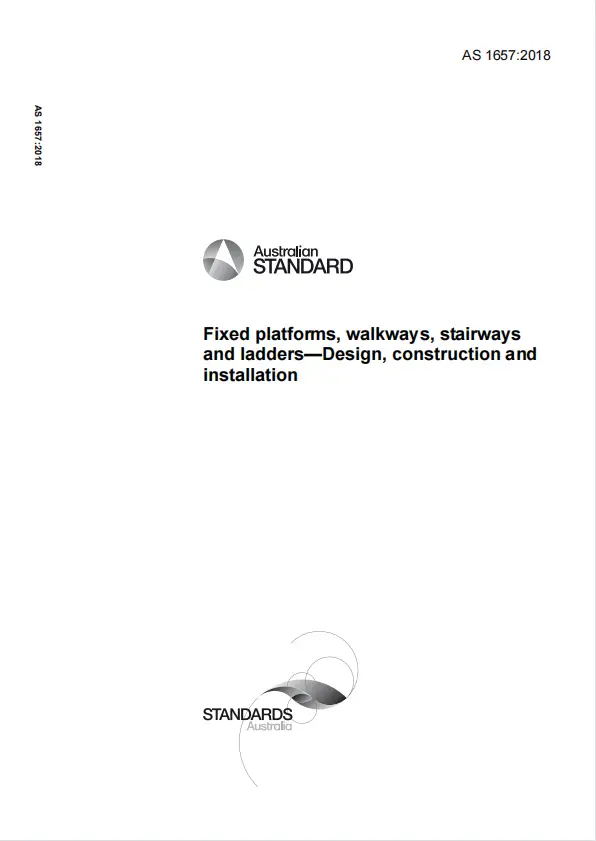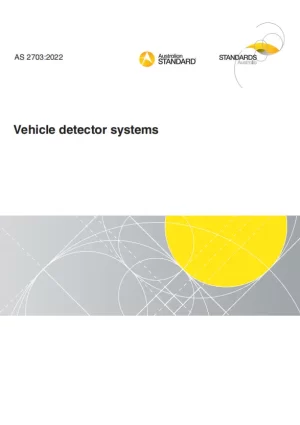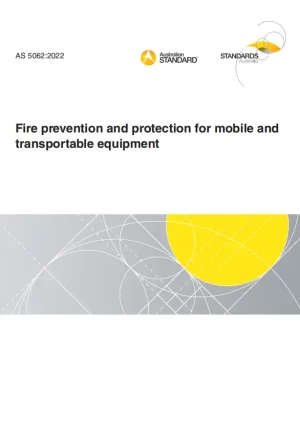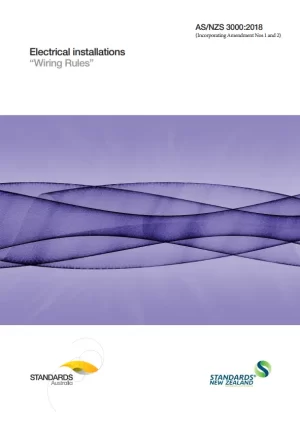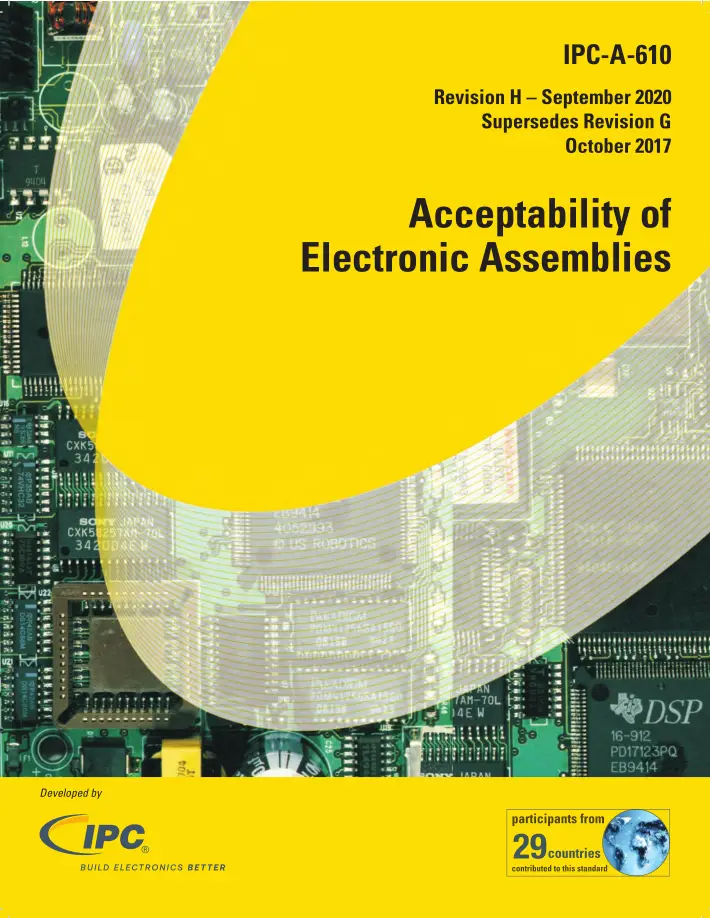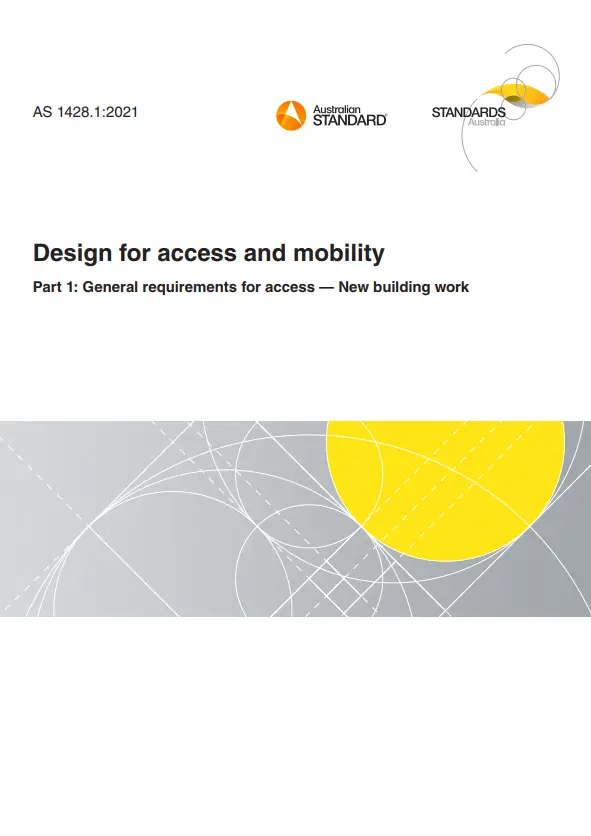AS 1657, 5th, 2018 – Fixed platforms, walkways, stairways and ladders – Design, construction and installation
AS 1657 sets out requirements for the design, selection, construction and installation of fixed platforms, walkways, stairways and ladders that are intended to provide safe access to places used by operating, inspection, maintenance and servicing personnel.
This Standard also applies to the following:
(a) Movable platforms that are permanently configured but that may be site adjustable or site assembled/modified.
(b) Permanently installed roof access, where such access is for the purpose of installing, operating, inspecting, maintaining or servicing equipment that is located on, or is accessible from, the roof.
(c) Permanently installed access for inspection and maintenance of the roof itself.
NOTES:
1 In the absence of a directly applicable Standard, this Standard may be used for guidance in providing access to some parts of stationery and mobile machinery, light and telecommunication towers, wind turbine towers and water and sewerage facilities. While such access may not be capable of conforming to all the requirements of this Standard, the principles and imposed actions should be followed.
2 Appendix A provides information on recommended component dimensions and materials for edge protection.
3 Appendix F provides a method for testing the load-carrying capacity of a twin-stile or single-stile fixed ladder.
4 Appendix G provides information on selection of stairways, walkways and fixed ladders.
5 Appendix H provides guidelines for fall protection measures for various types of ladders.
6 Appendix I provides design, fabrication and installation considerations for ladders to improve their safety and reduce the likelihood of injury to users.
7 Appendix J provides guidelines for roof access for the purposes of routine equipment or building maintenance activities.
General Product Information:
| Committee |
SF-013 |
| Purchase Note |
All current amendments available at time of purchase are included with the purchase of this document |
| Document Type |
PDF |
| ISBN |
978-1-76072-042-1 |
| Pages |
104 |
| Document Language |
English |
| Publisher |
Standards Australia |
| Status |
Current |
Preview
Table of cotents
Preface
1 Scope and general
1.1 Scope
1.2 Exclusions
1.3 Normative references
1.4 Definitions
2 Means of access
2.1 General
2.2 Selecting a means of fixed access
3 Design and fabrication
3.1 General design requirements
3.1.1 General
3.1.2 Loading
3.1.3 Slip resistance
3.1.4 Difference in height of walkways, platforms and landings
3.1.5 Headroom
3.1.6 Fixing of guardrailing components
3.2 Materials
3.2.1 General
3.2.2 Metals
3.2.2.1 Galvanized steel pipe
3.2.2.2 Ungalvanized steel pipe
3.2.3 Flooring materials
3.2.3.1 Timber
3.2.3.2 Metal plate
3.2.3.3 Concrete
3.2.3.4 Grating and expanded metal
3.3 Fabrication
3.3.1 Welding
3.3.2 Fixings
3.3.3 Corrosion protection
3.3.4 Floors
4 Platforms and landings
4.1 General requirements
4.1.1 Maximum slope
4.1.2 Access between adjacent platforms and landings
4.1.3 Width
4.1.4 Headroom
4.1.5 Protection
4.1.6 Design and fabrication
4.2 Design loads for floors
4.3 Platform surfaces
4.4 Guardrailing
4.5 Safety below the platform or landing
4.6 Toeboard
4.7 Edges
5 Walkways
5.1 General requirements
5.1.1 Maximum angle of slope
5.1.2 Access between adjacent walkways
5.1.3 Width
5.1.4 Headroom
5.1.5 Safety below the walkway
5.1.6 Design and fabrication
5.2 Design loads for walkways
5.3 Walking surfaces
5.3.1 Installation
5.3.2 Slip resistance
5.3.3 Cleats
5.4 Guardrailing
5.4.1 Provision of guardrailing
5.4.2 Requirements for walkways with slopes within the range of 15° to 20°
5.5 Toeboard
5.6 Handrails
5.6.1 General
5.6.2 Height
5.6.3 Hand clearance
5.6.4 Handrails dimensions
5.6.4.1 Circular
5.6.4.2 Rectangular
5.6.4.3 Other shapes
5.6.5 Toeboard
6 Physical edge protection
6.1 Design
6.1.1 Guardrailing
6.1.2 Toeboard
6.1.3 Infill
6.1.4 Verification and testing
6.2 Specific requirements
6.2.1 Guardrailing
6.2.1.1 General
6.2.1.2 Post and rail construction
6.2.1.3 Welded mesh construction
6.2.1.4 Infill
7 Access between levels
7.1 Design
7.1.1 Stairways
7.1.2 Fixed ladders
7.1.2.1 Twin-stile ladders (step-type or rung-type)
7.1.2.2 Single-stile ladders
7.1.2.3 Individual-rung (step-iron) ladders
7.1.2.4 Design actions for fixed ladders
7.1.3 Verification and testing
7.2 Stairways
7.2.1 Width and angle of slope
7.2.2 Flights
7.2.3 Stairs
7.2.3.1 Treads
7.2.3.2 Risers and goings
7.2.3.3 Headroom
7.2.3.4 Nosing
7.2.4 Landings
7.2.5 Guardrailing
7.2.6 Handrails
7.3 Step-type ladders
7.3.1 Width and angle of slope
7.3.2 Ladder enclosures
7.3.3 Treads
7.3.3.1 Dimensions of treads
7.3.3.2 Spacing of treads
7.3.4 Handrails
7.3.5 Clearances
7.3.6 Landings
7.4 Twin-stile rung-type ladders
7.4.1 Angle of slope
7.4.2 Stiles
7.4.2.1 Width
7.4.2.2 Cross-section
7.4.3 Rungs
7.4.3.1 General
7.4.3.2 Spacing of rungs
7.4.3.3 Variation of top rung/tread spacing
7.4.3.4 Variation of bottom rung/tread spacing
7.4.3.5 Allowable cross-slope at base of ladder
7.4.4 Fastenings
7.4.5 Clearances
7.4.6 Landings
7.4.7 Ladder cage
7.4.8 Extension above landings
7.4.8.1 Step-through ladders
7.4.8.2 Side access ladders
7.4.8.3 Access through horizontal openings
7.4.8.4 Ladder landing
7.4.8.5 Handrails
7.5 Single-stile rung-type ladders
7.5.1 General
7.5.2 Angle of slope
7.5.3 Stile cross-section
7.5.4 Rungs
7.5.4.1 General
7.5.4.2 Rung spacing
7.5.4.3 Fastenings
7.5.5 Clearances
7.5.6 Landings
7.5.7 Extension above landings
7.5.7.1 General
7.5.7.2 Side access
7.5.7.3 Access through horizontal openings
7.5.8 Ladder stile
7.5.9 Handrails
7.6 Individual-rung (step-iron) ladders
7.6.1 General
7.6.2 Angle of slope
7.6.3 Rungs
7.6.3.1 General
7.6.3.2 Rung spacing
7.6.3.3 Rung dimensions
7.6.3.4 Fastenings
7.6.3.5 Product testing and evaluation
7.6.4 Landings
7.6.5 Ladder cage
7.6.6 Extension above landings
8 Labelling and documentation
8.1 General
8.2 Labelling of installation
8.3 Documentation to be supplied
Appendix A
Appendix B
B1 Introduction
B2 Principle
B3 Apparatus
B4 Procedure
B4.1 Assembly
B4.2 Test forces
B4.3 Deflection
B4.4 Preload
B4.5 Test 1: Horizontal point load at top of post—Deflection
B4.6 Test 2: Horizontal point load on top rail or intermediate rail—Deflection
B4.7 Test 3: Vertical point load on top rail or intermediate rail—Deflection
B4.8 Test 4: Horizontal UDL on top rail or intermediate rail—Deflection
B4.9 Test 5: Horizontal point load at top of post—Ultimate
B4.10 Test 6: Horizontal UDL on top rail or intermediate rail—Ultimate
B4.11 Test 7: Horizontal point load on top rail or intermediate rail—Ultimate
B5 Pass/fail criteria
B5.1 Tests 1 to 4
B5.2 Tests 5 and 6
B6 Report
Appendix C
C1 Scope
C2 Principle
C3 Acceptance criteria
C4 Apparatus
C5 Procedure
C5.1 Horizontal point load test
C5.2 Horizontal pressure/wind load test
C6 Report
Appendix D
D1 Scope
D2 Principle
D3 Apparatus
D4 Procedure
D4.1 Settling load
D4.2 For treads and landings of width ≤1.36 m
D4.3 For treads and landings of width >1.36 m
D4.4 For all treads and landings in a stair assembly
D5 Report
Appendix E
Appendix F
F1 Scope
F2 Principle
F3 Apparatus
F4 Procedure—rung/tread tests
F4.1 Settling load
F4.2 Test 1—Rung/tread strength test
F4.2.1 Procedure
F4.2.2 Acceptance criteria
F4.3 Test 2—Rung/tread shear strength test
F4.3.1 Procedure
F4.3.2 Acceptance criteria
F5 Procedure—ladder stile tests
F5.1 Settling load
F5.2 Test 3—Ladder stile deflection test
F5.2.1 Procedure
F5.2.2 Acceptance criteria
F5.3 Test 4—Ladder stile strength test
F5.3.1 Procedure
F5.3.1 Acceptance criteria
F5.4 Test 5—Ladder stile side sway test
F5.4.1 Procedure
F5.4.2 Acceptance criteria
F5.5 Test 6—Ladder stile extension deflection test
F5.5.1 Procedure
F5.5.2 Acceptance criteria
F5.6 Test 7—Ladder stile extension lateral deflection test
F5.6.1 Procedure
F5.6.2 Acceptance criteria
F6 Report
Appendix G
G1 General
G2 Selecting a walkway
G3 Selecting a stairway
G4 Selecting a fixed ladder
G4.1 General
G4.2 Step-type ladders
G4.3 Rung-type ladders (twin-stile ladders)
G4.4 Rung-type ladders (single-stile ladders)
G4.5 Individual-rung ladders (step-irons)
G5 Prevention of unauthorized access
G6 Fall protection from ladders
Appendix H
H1 General
H2 Fall protection on ladders
H3 Allowance for harness-based fall-arrest equipment
H4 Application of fall protection to ladders
Appendix I
I1 Scope
I2 Transition to the top landing
I3 Twin-stile rung-type ladders—rung shapes
I4 Twin-stile rung-type ladders—rung considerations
I5 Step-type ladders—tread spacing
I6 Ladder cages
I7 Harness-based fall protection for ladders
I8 Top and bottom ladder landings
I9 Intermediate landing platforms
Appendix J
J1 General
J2 Access to a roof
J2.1 Internal access
J2.2 Access from roof edge
J3 Guardrailing
Bibliography

